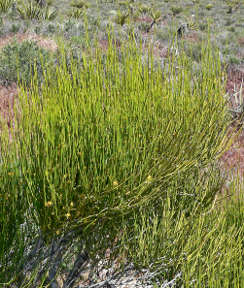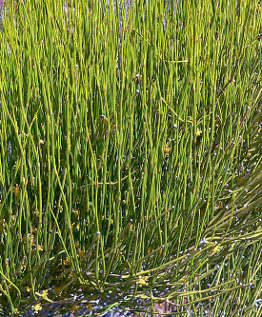 Ephedra viridis
Ephedra viridisDesert Tea
There are lots of Saturn connections with this magic herb. It likes dry, rocky soil, has a bony look, contains a lot of drying tannin, like black tea, so there seems to be a strong Saturn influence on this plant. There are also reports that this plant can live a very long time; one researcher found a plant that was 81 years old, so there's another Saturn indication. This primitive plant is distantly related to yew, which right away indicates some interesting magical uses. However, it's also got its Venus side, despite not having the lush flowers we usually associate with that planetary influence. For one, it has long been used for skin issues like burns sores. The Hopi made a poultice of it for syphillis sores. Although it is often called Mormon tea, actual pioneer Mormons did not make a tea* from this herb; it didn't even grow in the areas they passed through or originally settled in. Instead, a fellow named Jack Mormon introduced it at a bordello as a treatment for syphillis during the Nevada gold rush; this is why another name for it is "whorehouse tea." The Kawaiisu drank Mormon tea for backaches, but they also turned the twigs into charcoal to make tattoo ink, tattoos as skin decoration being another Venus-ruled (the stems are a good shape for drawing charcoal as well). So we've got Saturn and Venus influences pretty strong in this plant, which to me says consider it for long-lasting spellwork that is NOT baneful but perhaps more about delineating borders, a good Saturn use, or for drying up old love spells. Top
 Since it arose before the popularity of big leaves
in the plant world, desert tea doesn't produce
much leafage, but the stems are fine yellow green
even in winter.
It's a striking plant in xeriscaping and
good to have on hand for health issues. It's a decongestant that
is
not regulated like its Chinese cousin, Ephedra sinica. Stems
are usually roasted before being boiled for tea.
The Navajo
drank desert tea for coughs; it dilates the bronchia without being stimulating.
The Paiute used this magic herb for rheumatism. The Navajo made a tan dye with alum as a mordant from the above-ground
parts of this plant, so consider it for use in ritual dyeing, especially
when coloring Saturn objects; the tannin content implies it can
be combined with other dyeplants to make their colors more lasting. Deer and other ruminants
like to eat the stems, especially in winter, and smaller mammals
and birds like the seeds, but it's toxic to pregnant cows and
pregnant sheep. Horses won't touch it, but goats love it, and ants relish
the seeds enough to carry them off to their homes, so consider desert
tea as a fodder for wild animals. Top
Since it arose before the popularity of big leaves
in the plant world, desert tea doesn't produce
much leafage, but the stems are fine yellow green
even in winter.
It's a striking plant in xeriscaping and
good to have on hand for health issues. It's a decongestant that
is
not regulated like its Chinese cousin, Ephedra sinica. Stems
are usually roasted before being boiled for tea.
The Navajo
drank desert tea for coughs; it dilates the bronchia without being stimulating.
The Paiute used this magic herb for rheumatism. The Navajo made a tan dye with alum as a mordant from the above-ground
parts of this plant, so consider it for use in ritual dyeing, especially
when coloring Saturn objects; the tannin content implies it can
be combined with other dyeplants to make their colors more lasting. Deer and other ruminants
like to eat the stems, especially in winter, and smaller mammals
and birds like the seeds, but it's toxic to pregnant cows and
pregnant sheep. Horses won't touch it, but goats love it, and ants relish
the seeds enough to carry them off to their homes, so consider desert
tea as a fodder for wild animals. Top
A native of the Southwest of North America, desert tea is a cardiac stimulant that is longer lasting than adrenaline. We've seen conflicting information about whether desert tea contains ephedrine. According to one scientific article Harold found, it has pseudoephedrine instead, which is the same stuff as in Sudafed. Everything else he read has said it does not contain any alkaloids whatsoever. It has become popular with people on weight-loss diets and with bodybuilders because of its stimulant and diaphoretic (makes you sweat) and diuretic (which made the Chumash tribe use it for bladder infections) properties and because companies apparently want to hoodwink people into believing it is the same thing as Ephedra sinica only legal. It is legal, but it's not the same at all. Personally, we would feel suspicious of anything labeling itself as "ephedra tea." Experience has taught that when there is a great demand for an herb, adulteration is likely. This is why we suggest growing your own. This magic herb is also known as popotillo, Mexican tea, American ephedra, Indian tea, squaw tea, teamster's tea, Brigham tea, mountain tea, desert tea, green jointfir, green ephedra, and of course, Mormon tea. Top
How to Grow Desert Tea: You can simply soak the seeds for 24 hours, changing the water every 8 hours, and then plant, or you can cold stratify seeds for 1 month and plant in sandy mixture or peat with plenty of perlite/vermiculite. It will germinate in 4 weeks. Transplant to full sun. It likes dry, rocky areas and can grow at high elevations. It is fine with most types of soil but doesn't like it wet, although more female plants will grow in moister soils. Thunderstorms can cause seeds to scatter with this plant. It can get 10"-5ft/25cm-1.5m tall, but it might take 5 years to reach 2ft/60cm. This seed is very long lived and can still germinate after 20 years, showing Saturnian influences. The stems can be harvested at any time, dried, and stored to use later. This perennial is hardy down to zone 5 (-20F/-29C), a temperate climate. General growing info Top
Ephedra viridis
Desert Tea
20 seeds
$3.75
Uses in Witchcraft & Magic:
Ritual Dye
Tattooing
Saturn/Venus
Herb
© 2013-2024 Alchemy Works; No reproduction without permission
*Mormons drank a composition tea created by Brigham Young containing cayenne, bayberry bark, hemlock tree bark, ginger, and cloves.